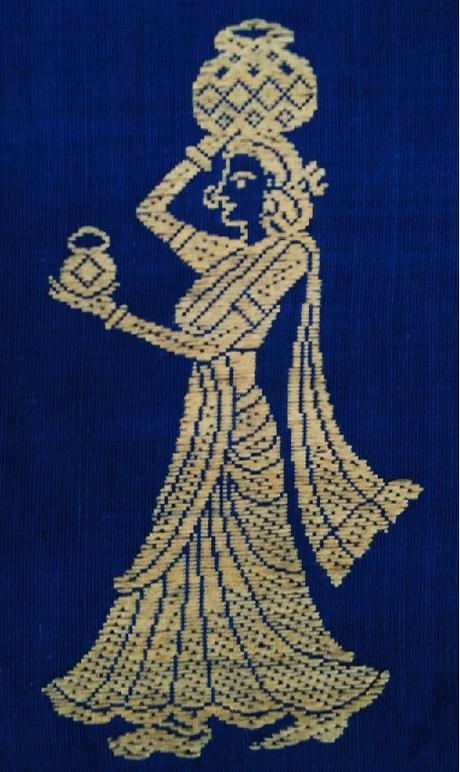With close to 150 unique weaves, India is a treasure trove when it comes to indigenous textiles and regional handlooms. A reflection of our rich cultural heritage and tradition, the stories behind these weaves are often as magical and fascinating as the textiles themselves. A case in point is the unique Gollabhama sarees of Siddipet, a small city about 100 km north of Hyderabad. Gollabhama sarees whose name is derived from the “Gollabhama” motif (the motif of a milkmaid carrying a pot of milk on her head) was recently recognized as an iconic textile craft of India by UNESCO. This is indeed a testament to the unique craftsmanship associated with these sarees.

Gollabhama motif_Pic credit Dr. Sunanda R Kalakannavar
" data-orig-size="509,855" sizes="(max-width: 509px) 100vw, 509px" aperture="aperture" />Gollabhama motif_Pic credit Dr. Sunanda R KalakannavarOrigins steeped in myth and folklore
The origin of the Gollabhama motif and saree dates back over 60 years ago and is inspired by the womenfolk of the pastoral Golla or Yadava community. These women famously carried a pot of milk on their heads along with a bowl of curd in one hand while distributing it from house to house. It is said that the weavers of the yesteryears were inspired by the image created by the shadow of these women which they replicated on fabric. According to folklore, during the Dwaparyuga age, milkmaids carried pots of milk as on offering to Lord Krishna and this silhouette was recreated by weavers resulting in the Gollabhama motif. Another theory refers to a movie made in the 1940s which was based on King Vikramaditya and his queen named “Gollabhama” and this movie is believed to be the story behind the Gollabhama sarees.
Steady revival in the recent years
Irrespective of the theories, Gollabhama sarees were a rage during the heydays in Siddipet. It is said that around the 1960s there were close to 2000 weavers and hundreds of looms in the city. Weaving the motif and the saree was a laborious task and with the passage of time and the advent of power looms, the number of weavers, like many other handloom textiles, drastically reduced till the craft reached its nadir in the early 2000s. But with measures being adopted for the welfare of the weavers and concerted efforts towards revival, Gollabhama sarees have seen a steady comeback in the last decade. Dr. Sunanda R Kalakannavar, Textile and Fashion Designer has played a major role in spearheading the revival process. She has done in-depth research on Gollabhama sarees and worked closely with the weavers of Adarsh weavers’ society in Siddipet. While the Gollabhama sarees were accorded the Geographical Indication (GI tag) in early 2012, extensive work was done by Dr. Sunanda from 2016 as part of her Post-Doctoral Fellowship in terms of using advanced technology, natural dyes and several production and marketing nuances to make Gollabhama sarees a viable product in the market.
The sarees soon started gaining visibility and with celebrities like Samantha Prabhu and fashion designer Shravan Kumar rooting for the craft, the awareness about the saree grew manifold. In fact, an ethnic Gollabhama saree was chosen as a gift for Ivanka Trump when she visited Hyderabad in Nov 2017.
The weaving of the Gollabhama saree is a unique one in that the intricate motifs are hand woven on the fabric; it is neither printed nor embroidered. This done by meticulously passing multiple-coloured threads through the warp to get the clear design. This requires both skill and precision. The sarees come either in a single color or with a contrast border and pallu with the motifs adorning the body, border and pallu. The motifs usually come in 3 sizes of 14, 7 and 1.5 inches for the pallu, border and body respectively.
Apart from cotton, the sarees are also woven in pure silk too. While a single saree takes about 3 days, dupattas which are a relatively new product are made in a day and the weavers are paid for each finished product they make. According to Gundla Hanumanth, Manager at Adarsha Handloom Weavers’ Cooperative Society, there are about 40 Gollabhama saree weavers currently in Siddipet across four societies. “While there has been improvement since the last 15 years, much more is needed in terms of training, support and monetary incentives for the next generation to take up weaving and keep the craft alive” says Hanumanth who added that currently each weaver is paid INR 1500-1800 for each saree they weave.
With some independent weavers slowly embracing social media, they are able to see sell their products online. Thumma Praveen Kumar who is the son of veteran weaver Thumma Galaiah is one of them. He actively interacts with customers all over India via his Facebook page and through WhatsApp. While the prices of silk sarees start from INR 11,000/-, cottons start at INR 2700/-. “Many a time customers find INR 2700/- expensive for a cotton handloom saree. It is a tough task to convince everyone about the value of a handmade product. We need to build more awareness about these sarees which are a coveted asset of our city” says Praveen Kumar.
An edited version of this piece was published in The New Indian Express.
